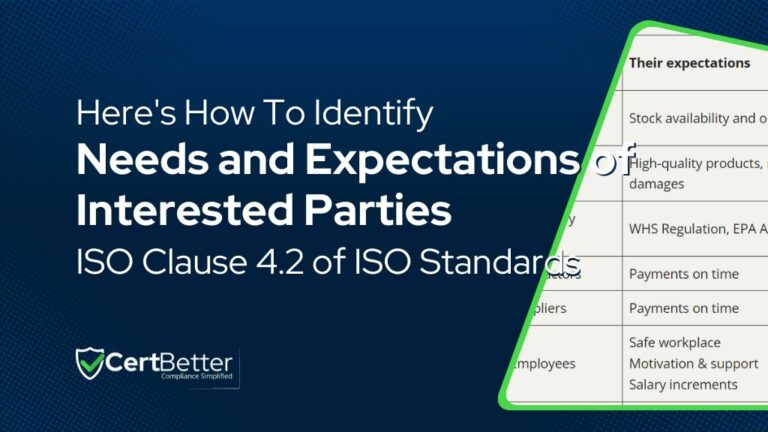Clause 4.2 Examples of Needs and Expectations of Interested Parties

If you’re looking for a practical understanding of how to identify the Needs and Expectations of Interested Parties as per clause 4.2 of popular ISO standards such as ISO 9001, ISO 14001, ISO 45001 and ISO 27001, then you’re in the right place. In this CertBetter article, we’ll dive into the concept of interested parties within the ISO framework, understanding why their needs and expectations matter and how you can effectively identify them within your businesses for better success.
Clause 4.2 FAQs
What are the interested parties as per Clause 4.2?
Is Clause 4.2 part of ISO certification audits?
Does ISO certification require a list of interested parties?
Is identifying interested parties a one-time activity?
Is the interested party a person or organisation?
By the end of this article, you should be able to identify and implement the needs and expectations of your business’s interested parties. Let’s get started..
What is an Interested Party?
Like I mentioned in the FAQs, the interested party could be anyone who is ‘interested‘ either in your business activities or affected by your business activities. Understanding these parties or stakeholders should be your first step as part of the overall context of the organisation process.
Once you realise this ISO concept, you naturally know who’s your interested party and what is expected.
Think of it this way: when you establish a business, probably the first person you hire is your accountant to plan and sort out all the financial matters so it’s easier to run your business when you interact with your potential customers.
The accountant becomes an interested party in your business because there’s some level of need and expectation between them and your business.
Why Interested Parties and their Expectations Matter?
Identifying the interested parties and understanding their needs and expectations is indeed the most important aspect of any effective management system. Within the framework of ISO standards, this identification process is crucial for several reasons:
Enhanced Stakeholder Relationships:
Knowing who your interested parties are and what they expect from your organisation helps build stronger and trusting relationships. When stakeholders feel their needs and expectations are understood and valued, they are more likely to support and engage positively with your organisation.
Risk Management:
Understanding the needs and expectations of interested parties helps in identifying potential risks and opportunities. By foreseeing and addressing these concerns proactively, organisations can mitigate risks and capitalise on opportunities more effectively.
Improved Decision Making:
Awareness of the needs and expectations of different stakeholders enables more informed and balanced decision-making. Organisations can align their strategies and operations in ways that meet or exceed these expectations, leading to better outcomes.
Sustainable Business Practices:
Considering the needs and expectations of the environment and community can guide organisations towards more sustainable and socially responsible business practices. Recently, ISO has been working to publish an update to include climate change in 9001.
Regulatory Compliance:
Many interested parties are regulatory bodies such as WorkSafe in Victoria whose requirements are mandatory for legal operation. Identifying and understanding these requirements is essential for maintaining compliance and avoiding legal issues.
Customer Satisfaction:
In almost every business case, customers are key interested parties. Understanding and meeting their needs is fundamental to achieving customer satisfaction, which is directly linked to business success.
ISO Compliance:
For organisations seeking ISO certification, identifying interested parties is a requirement. It demonstrates a commitment to quality, environmental management, or other areas covered by ISO standards.
Employee Engagement:
Employees are also crucial stakeholders. Recognising their needs and expectations can lead to higher engagement, improved morale, and better performance.
Recommended read: Examples of Clause 4.1 Understanding Organisation and its Context.
What is Required by Clause 4.2 of the ISO standards?
If you look at the most popular ISO standards, you’ll notice a commonality in their wording. Yet, each standard anticipates different needs and expectations based on the specific management system it addresses.
While the language of clause 4.2 may seem similar across various standards, the application and focus can vary significantly, tailored to suit the unique requirements of each management system.
ISO 9001:2015 Quality Management
If you are certifying or managing a Quality Management System compliant with ISO 9001, Clause 4.2 generally emphasises the importance of having a robust supply chain. This is crucial to consistently meeting both customer needs and regulatory requirements.
This clause underlines the need for effective management system of your supply chain to ensure the quality of products and services, reflecting the system’s focus on customer satisfaction and adherence to applicable regulations.
4.2 Understanding the needs and expectations of interested parties
Due to their effect or potential effect on the organization’s ability to consistently provide products and services that meet customer and applicable statutory and regulatory requirements, the organization shall determine:
a) the interested parties that are relevant to the quality management system;
b) the requirements of these interested parties that are relevant to the quality management system.
The organization shall monitor and review information about these interested parties and their relevant requirements.
ISO 14001:2015 Environmental Management
If your business is in the process of achieving ISO Certification for an Environmental Management System compliant with ISO 14001, Clause 4.2 typically focuses on the importance of understanding environmental needs and obligations relevant to your business.
You now change your focus from quality to understanding how your supply chain and operational processes interact with the greater environment (typically, water, land and air) and identifying any relevant environmental regulatory requirements.
4.2 Understanding the needs and expectations of interested parties
The organization shall determine:
a) the interested parties that are relevant to the environmental management system;
b) the relevant needs and expectations (i.e. requirements) of these interested parties;
c) which of these needs and expectations become its compliance obligations.
ISO 45001:2018 OH&S Management
If you are certifying or managing an Occupational Health and Safety Management System compliant with ISO 45001, Clause 4.2 emphasises the significance of identifying and understanding the needs and expectations of workers and other interested parties regarding workplace health and safety.
Now the focus is on how your business operations (including the supply chain) impact the safety and health of your interested parties, such as workers, and understanding the legal and regulatory requirements in this area.
The clause highlights the importance of actively managing these aspects to ensure a safe working environment, prevent workplace injuries and illnesses, and meet the expectations of employees, regulatory bodies and other stakeholders concerned with health and safety.
4.2 Understanding the needs and expectations of workers and other interested parties
The organization shall determine:
a) the other interested parties, in addition to workers, that are relevant to the OH&S management system;
b) the relevant needs and expect ations (i.e. requirements) of workers and other interested parties;
c) which of these needs and expectations are, or could become, legal requirements and other requirements.
ISO 27001:2022 Information Security Management
Similarly, if your business has an Information Security Management System compliant with ISO 27001:2022, Clause 4.2 places emphasis on understanding the information security needs and expectations of interested parties.
The first step should be identifying how your business operations and processes handle sensitive information and the associated risks. Clause 4.2 highlights the necessity of comprehensively managing these aspects to safeguard information confidentiality, integrity and availability (CIA concept).
The clause calls for an effective approach to address the concerns of stakeholders such as customers, employees, business partners and regulatory bodies, ensuring compliance with legal and contractual obligations related to information security.
4.2 Understanding the needs and expectations of interested parties
The organization shall determine:
a) interested parties that are relevant to the information security management system;
b) the relevant requirements of these interested parties;
c) which of these requirements will be addressed through the information security management system.
NOTE The requirements of interested parties can include legal and regulatory requirements and contractual obligations.
How do you identify Interested Parties & their Needs?
Let’s take the previous example to the next level. Imagine if your business has a few shareholders. As part of your business reporting, you need to prepare financial statements with the help of an accountant.
Now you’ve got two interested parties: Shareholders and Accountant.
The shareholders need annual reports of your business and to achieve that, your accountant needs proper records of your financial transactions.
Congratulations! You just identified two needs and expectations (an annual report and proper records) in relation to your two interested parties.
You might be thinking there could be hundreds of interested parties connected with your business so what’s the most efficient way to implement this clause?
It’s actually quite simple. The ISO standards highlight the importance of risk-based thinking and embedding it into your business management through a process driven approach.
The best way to go about this is to identify the most important needs or expectations of your interested parties or stakeholders for your business. I often see lists like this one:
Once you know who’s an interested party or stakeholder, the next step is to identify their needs and expectations. It could also be your business needs and expectations, theirs or even mutual.
Remember: The idea is to understand the most important needs and expectations (risk-based thinking) in the most general way without going into too many details. Why? Because this will help you keep things simple for your strategic reviews.
Once you’ve got a good list that is relevant to your business, the next step is to understand the expectations from both sides. Here’s an example list of interested parties and their needs and expectations.
| Interested Party | Their expectations | Your expectations |
| Customers | Stock availability and on time | Payments in advance |
| End Users | High-quality products, no damages | No major complaints |
| Regulatory bodies | WHS Regulation, EPA Act | No notices/fines |
| Contractors | Payments on time | Safe working |
| Suppliers | Payments on time | stock on schedule |
| Employees | Safe workplace Motivation & support Salary increments |
Task completion Less absenteeism Work safely |
| Director(s) | Increase in profits Improved branding |
Lead by example Provide resources |
That’s it! There’s your list of interested parties and their needs and expectations as per clause 4.2 of ISO standards. This approach works for any management system. Just shift your focus, think about risks and keep it simple.
Final Words
I hope you’ve enjoyed this article on identifying the needs and expectations of interested parties as per clause 4.2 of ISO standards. Remember, it’s all about wearing a different hat to do this exercise. Always try risk-based thinking and write something simple as above, so when you’re talking about business targets, strategies or perhaps making future changes as part of your growth plans, you clearly understand how that’s going to impact your business performance (and influence interested parties) so you’re well prepared and avoid any surprises!
- Last updated: May 22, 2024
- CertBetter
Our community of compliance professionals and ISO experts is ready to provide you with insightful answers and practical solutions. Join the discussion now!
- Recommended Reads
- 33 reads
-
Frequently Asked Questions
Understanding ISO Terminology: Guide to Important Terms and Concepts
No posts found
ResetConnect with ISO Certification Consultants
CertBetter makes it easy to find ISO certification consultants and compliance professionals from around the globe.

